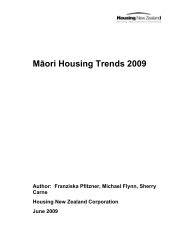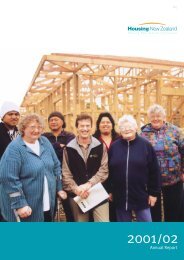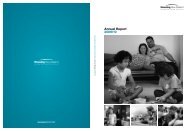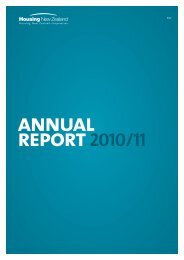MÄori Housing Trends 2010 - Housing New Zealand
MÄori Housing Trends 2010 - Housing New Zealand
MÄori Housing Trends 2010 - Housing New Zealand
You also want an ePaper? Increase the reach of your titles
YUMPU automatically turns print PDFs into web optimized ePapers that Google loves.
<strong>Housing</strong> SupplyIntroduction98 In order to consider the adequacy of housing supply for Māori, this chapter beginswith an overview of Māori housing need. These findings were part of a broaderstudy into Māori housing experiences 32 and were based on qualitative fieldwork withMāori householders and key informants in six localities throughout <strong>New</strong> <strong>Zealand</strong>.The next section focuses on trends in household and population crowding as a keyindicator of the restricted housing supply for Māori, and identifies some factorsassociated with household crowding.99 There are multiple ways to define the level of crowding. Statistics <strong>New</strong> <strong>Zealand</strong> arecurrently undertaking some work around identifying which crowding measure is themost appropriate for the <strong>New</strong> <strong>Zealand</strong> context. The crowding data presented in thissection is based on the Canadian National Occupancy Standard (CNOS 33 ).<strong>Housing</strong> needs100 Based on qualitative fieldwork, it was found 34 that there was overall agreement thatthe housing needs of Māori differed from other peoples, to the extent that Māoritended to need to accommodate a larger number of people than was usually thecase with the general population. This was associated with larger family size and thepractice of receiving and accommodating visiting whānau and other visitors on arelatively frequent basis for short periods, for example for tangihanga, and otherwhānau gatherings. All respondents unequivocally stated that being able toaccommodate guests was important.101 In addition, many participants in this research identified the desirability of being ableto accommodate another whānau member or members, usually a parent(s) orgrandparent(s) on a permanent basis. This desire was expressed by rural and urbanrespondents.32 Waldegrave et al. (2006).33 The standard sets the bedroom requirements of a household according to the followingcomposition criteria: there should be no more than two people per bedroom; parents or couplesshare a bedroom; children under five years, either of same or opposite sex, may reasonablyshare a bedroom; children under 18 years of the same sex may reasonably share a bedroom; achild aged five to 17 years should not share a bedroom with one under five of the opposite sex;single adults 18 years and over and any unpaired children require a separate bedroom.34 Waldegrave et al. (2006: 104).25














